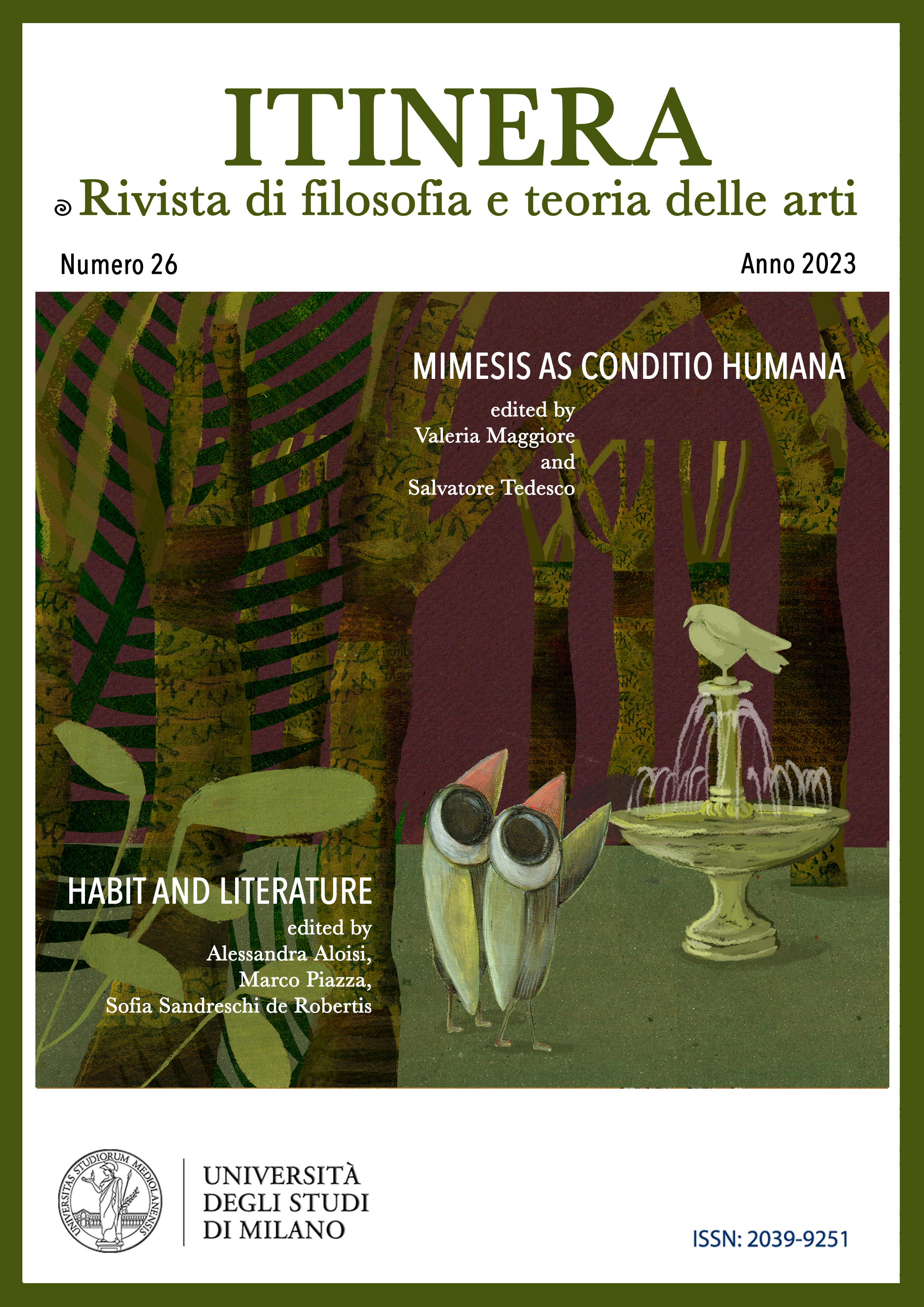Editoriale: Mimesis come conditio humana
Parole chiave:
Mimesis, imitation, autopoiesis, conditio umana.Abstract
The concept of mimesis originates in the Greek context in the 5th century BC, and since then, it has been at the heart of Western aesthetic reflection. It finds its best-known formulation in the Aristotelian affirmation that “art imitates nature”; however, as C. Wulf has emphasised, the mimetic faculty plays a role not only in the art domain but also in almost all areas of human action, representation, speech and thought:mimesisis aconditio humana. Thus, alongside the passive-imitative meaning of mimesis, we can also identify an active meaning of the term since it indicates a process that leads us to encounter external reality aesthetically and to reproduce its traits creatively, even in our bodies. The topicality of the question lies in this complexity, which connects mimesis not only to the terms of imitation but also to those of individual plasticity and autopoiesis.
Riferimenti bibliografici
AA. VV., Enciclopedia filosofica, vol. 8 – Men-Pap, Bompiani, Milano 2006, pp. 7451-7453.
Auerbach, E., Mimesis: The Representation of Reality in Western Literature, Princeton University Press, Princeton and Oxford 2003.
Desideri F., Talon-Hugon C., Ways of Imitation, numero monografico di “Aisthesis on-line”, vol. 10, 2017.
Diderot, D., I Salons. Edizione integrale con i saggi sulla pittura e i pensieri sparsi. Testo francese a fronte, trad. it a cura di M. Mazzocut-Mis, Bompiani, Milano 2021.
Franzini E., Mazzocut-Mis M., Estetica. I nomi, i concetti, le correnti, Bruno Mondadori, Milano 2000.
Gebauer G., Wulf C., Mimesis: Kultur, Kunst, Gesellschaft, Rowohlt Verlag, Reinbeck bei Hamburg 19982; trad. it di A. Borsari, F. Peri, Mimesis. Cultura – Arte – Società. La Vita e le Forme, Bononia University Press, Bologna 2017.
Halliwel, S., The Aesthetics of Mimesis. Ancient Texts and Modern Problems, Princeton University Press, Princeton and Oxford 2002.
Koller, H., Die Mimesis in der Antike, Bern 1954.
Mattioli, E. (a cura di), Mimesis, numero monografico di “Studi di estetica”, voll. 7-8, 1993.
Mattioli, E. (a cura di), Ragioni della mimesis, numero monografico di “Studi di estetica”, vol. 9 1994.
Mattioli, E. (a cura di), Poetiche della mimesis, numero monografico di “Studi di estetica”, vol. 10, 1994;
Mckeon, R., Literary Criticism and the Concept of Imitation in Antiquity, Critics and Criticism, Chicago 1952.
Melberg, A., Theories of mimesis, Cambridge University Press, Cambridge 1995.
Platone, La Repubblica. Testo greco a fronte, a cura di G. Reale, Bompiani, Milano 2009.
Platone, Il Sofista, tr. it a cura di B. Bianchini, Armando, Roma 1997.
Potolsky, M., Mimesis, Routledge, New York and London 2006.
Wulf, C., Mimesis, l’arte e i suoi modelli, Mimesis, Milano, 1995.
Wulf, C., Homo imaginationis. Le radici estetiche dell’antropologia storico culturale, a cura di F. Desideri, M. Portera, Mimesis Edizioni, Milano-Udine 2018.
Wulf, C., Human beings and their images. Imagination, mimesis and performativity, Bloomsbury, London 2022; trad. it di M. Portera, Gli esseri umani e le loro immagini. Fondamenti immaginari e performative degli studi culturali, Meltemi editore, Milano 2023.
Dowloads
Pubblicato
Fascicolo
Sezione
Licenza
Copyright (c) 2024 Alice Barale

Questo lavoro è fornito con la licenza Creative Commons Attribuzione - Condividi allo stesso modo 4.0.
Gli autori che pubblicano su questa rivista accettano le seguenti condizioni:
1. Gli autori mantengono i diritti sulla loro opera e cedono alla rivista il diritto di prima pubblicazione dell'opera, contemporaneamente licenziata sotto una Licenza Creative Commons - Attribuzione - Condividi allo stesso modo 4.0 internazionale che permette ad altri di condividere l'opera indicando la paternità intellettuale e la prima pubblicazione su questa rivista.
2. Gli autori possono aderire ad altri accordi di licenza non esclusiva per la distribuzione della versione dell'opera pubblicata (es. depositarla in un archivio istituzionale o pubblicarla in una monografia), a patto di indicare che la prima pubblicazione è avvenuta su questa rivista.
3. Gli autori possono diffondere la loro opera online (es. in repository istituzionali o nel loro sito web) prima e durante il processo di submission, poiché può portare a scambi produttivi e aumentare le citazioni dell'opera pubblicata (Vedi The Effect of Open Access).





